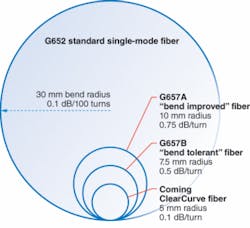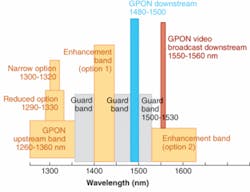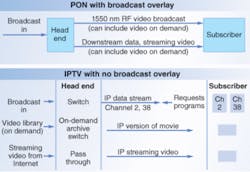PHOTONIC FRONTIERS: FIBER TO HOME - Fiber to the home takes aim at a ‘100-megabit nation’

Three decades after the first fiber to the home (FTTH) test bed began operating in Higashi-Ikoma, Japan, the technology has gone mainstream. In April, the Fiber to the Home Council reported 2.91 million fiber subscribers in the United States, nearly double the number a year earlier. The survey by Michael Render of RVA Market Research (www.rvallc.com; Tulsa, OK) found that 1.6 million customers received video through their fiber links, and that FTTH systems passed 11.8 million homes in North America. In June, a group of congressmen including the influential Ed Markey (D-MA) introduced a resolution into the House urging that broadband systems delivering 100 Mbit/s be made available throughout the country by 2015.
Meanwhile, the technology is evolving to meet those goals. One big push is in an area that consumers won’t notice directly improving installation economics. Another is in developing new architectures that upgrade transmission capacities without obsolescing earlier generations of hardware. But developers face a moving target as new services emerge with their own thirst for bandwidth, including high-definition television, video on demand, Internet-protocol TV (IPTV), telecommuting, and interactive gaming.
Improving installations
Scaling up FTTH systems has led to innovations to cut labor costs and eliminate cumbersome and complex equipment. Field technicians now screw preconnectorized fiber drop lines into terminals in home and pole-mounted boxes instead of splicing the fibers. “Within three or four years, we’ve gone from bulk fiber cable and regular boxes to pre-engineered interconnect systems,” says Mark Turner of Corning Cable Systems (Hickory, NC). “It’s amazing.”
Installation also has been aided by development of new fibers less sensitive to bends than standard types. Specifications set by the International Telecommunications Union (ITU) for type G.652 standard single-mode fiber call for loss of no more than 0.1 dB when wound 100 times around a mandrel with 30 mm radius of a 6 cm (2.75 in.) loop. But loss increases rapidly for tighter bends (see Fig. 1). The ITU G.657A standard calls for fibers to have loss no more than 0.75 dB in a single loop with 10 mm radius. The ITU G.657B standard specifies loss no more than 0.5 dB in a single loop with 7.5 mm radius. Developers have done better than current standards; Corning now offers a ClearCurve fiber that it specifies as having bend-induced loss no more than 0.1 dB in a full turnaround loop with 5 mm radius.
Bend-insensitive fibers originally were developed largely for use where fibers must be looped to store extra fibers or to make connections within terminal boxes. They also allow the use of smaller terminal boxes at homes, appreciated by homeowners who don’t like the looks of big boxes on their outside walls or in their garages. Most installations deliberately leave slack to allow for changes and repairs, and most preconnectorized drops require a slack box to hold excess cable. The push for fibers that can withstand even tighter bends comes from installations in apartment buildings and other existing housing, where cables may be run along molding and bent around tight corners.
Passive optical networks evolve
The architecture for the passive optical networks (PONs) that account for most FTTH systems was set in standards proposed by the Full Service Access Network group, (FSAN; www.fsanweb.org) and adopted by ITU. The PON design avoids putting any active elements between the local switching office and the subscriber; one single-mode fiber runs from the switching office to a distribution note, where the signal is divided among 16, 32, or sometimes 64 separate single-mode fibers serving individual customers.
The first widely used version is the Broadband PON (BPON) described in the ITU G.983 standard. It typically transmits a total of 622 Mbit/s downstream to subscribers at 1310 nm, and a total of 155 Mbit/s upstream from subscribers at 1490 nm. Signals are time-division multiplexed, with each customer getting a specific fraction of the total capacity. The 1550 nm window is reserved for downstream video transmission in the radio-frequency format used in cable-television networks.
An enhanced version called Gigabit PON (GPON) uses the same wavelengths and splitting ratios, but transmits at higher data rates2.488 Gbit/s downstream and 1.244 Gbit/s upstream. Details are specified in the ITU G.984 standard. In practice, signals are packet-switched rather than time-division multiplexed. Verizon uses this format in its FiOS system, which accounts for roughly 70% of all FTTH connections in the U.S.
Ethernet PON (EPON, also called GEPON for Gigabit Ethernet PON) transmits a payload of 1 Gbit/s in variable-length packets, with a line rate of 1.25 Gbit/s because it uses Ethernet-style 8 bit/10 bit encoding. Details are specified in the IEEE 802.3ah standard.
An alternative approach is point-to-point or switched Ethernet transmission, with a dedicated fiber between an Ethernet switch and each subscriber. This requires distributing active Ethernet switches in the field, but has the advantage of using mass-produced Gigabit Ethernet hardware. According to Render, it provides connections to about a quarter of homes served by FTTH networks other than Verizon’s.
Cranking up the bandwidth
In June, Verizon began offering bigger slices of the FiOS pie to customersdownstream data rates to 50 Mbit/s and upstream rates to 20 Mbit/s, and said it had successfully tested 100 Mbit/s transmission. But 10 or 20 Mbit/s downstream and 2 or 5 Mbit/s upstream suffice for most customers. Some other companies already offer 100 Mbit/s service, and Render’s survey found that 17,000 of their customers were paying for that premium service.Making 100 Mbit/s available to all FTTH customers will require boosting system capacity, and operators don’t want to scrap the networks they have already installed. To meet that goal, FSAN proposes overlaying existing GPON networks with two additional wavelengths that would not interfere with existing bands (see Fig. 2). The ITU last year published that as standard G.984.5. Signal transmission details have yet to be finalized, but FSAN plans to step up TDM transmission, probably to 10 Gbit/s downstream and 1.25, 2.5, or 5 Gbit/s upstream. Those speeds would require new electronics, but the new optical signals could be carried through the existing PONs without disrupting service to customers receiving slower speeds. An IEEE group is also working on an 802.3av standard for downstream transmission of 10 Gigabit Ethernet on PONs; upstream transmission would be at 1 or 10 Gbit/s.
In the longer term, developers are looking to higher-capacity standards that could be deployed in new systems but might not be compatible with older networks. Several ideas are being considered, which are based on extension of TDM, wavelength-division multiplexing (WDM), or some combination of the two. The issues are complex. A pure WDM system that assigns each customer a separate wavelength is conceptually simple, and could deliver about a gigabit, but the dense-WDM needed to serve many customers would require costly components, and the customer bandwidth couldn’t be changed dynamically. Coarse WDM would require less costly components, but couldn’t serve as many customers as DWDM unless each optical channel was subdivided into multiple TDM signals.
Higher bandwidth is not the only goal of next-generation PONs. Some network operators would like PONs that divide signals among 128 or 256 customers. Some operators also would like networks that reach customers up to 60 km away, instead of the 20 km of current GPONs. The potential tradeoffs are still being evaluated.
What will customers want?
The FTTH Council set its target of 100 Mbit/s as a measure of raw digital capacity, not specific services delivered. That’s appropriate for an organization dealing with the transmission capacity of hardware, and reaching 100 Mbit/s in 2015 or 2020 would be in line with the steady growth of digital connection speed for the past quarter century. Growth has been much slower in video services delivered over cable and satellite links. But customers are more concerned with services than bandwidth, and the available services and how they are delivered are in a state of flux.The most imminent change is next year’s final transition from analog to digital broadcast television in the USA, particularly high-definition digital (HDTV). Digital-to-analog converters and data compression that fits a single HDTV channel within the six-megahertz slots used for analog television ease the transition, but customers will see some changes in broadcast, cable, and satellite services.
A bigger long-term issue is the future of video delivery. Cable, satellite, and FTTH networks now offer “broadcast” services which deliver all channels to set-top-boxes or adapters that interface with televisions and let users select channels. An emerging alternative is switched digital video, in which the system transmits only the programs the customers want to watch, avoiding the need for a video overlay. The goal is to merge the switched video service with data (and voice) in a single Internet Protocol (IP) data stream, an architecture called IPTV (see Fig. 3). In principle, both can deliver video on demand as well as conventional video channels, but it remains to be seen how well they will work in the evolving market.
Meanwhile, emerging services will add to the demand for bandwidth. Streaming and downloaded videos are accounting for a growing share of Internet traffic, from YouTube to iTunes. Interactive gaming is growing. Developers are pushing Web-based software, hosted on remote servers rather than on user computers, and requiring broadband access. Record oil prices are giving new impetus to telecommuting. Will we ever have enough bandwidth?
RESOURCES AND FURTHER READING
FTTH Council; www.ftthcouncil.org
FTTH Prism newsletter; www.chaffeefiberoptics.com
Full Service Access Network www.fsanweb.org
IEEE Standards group
IEEE 10-gigE; www.ieee802.org/3/av/
IEEE Ethernet in the first mile task force; http://ieee802.org/3/efm/
Int’l. Telecommunications Union; www.itu.int
Gerd Keiser, FTTH Concepts and Applications (IEEE Press/Wiley, Hoboken, NJ, 2006).
About the Author
Jeff Hecht
Contributing Editor
Jeff Hecht is a regular contributing editor to Laser Focus World and has been covering the laser industry for 35 years. A prolific book author, Jeff's published works include “Understanding Fiber Optics,” “Understanding Lasers,” “The Laser Guidebook,” and “Beam Weapons: The Next Arms Race.” He also has written books on the histories of lasers and fiber optics, including “City of Light: The Story of Fiber Optics,” and “Beam: The Race to Make the Laser.” Find out more at jeffhecht.com.


